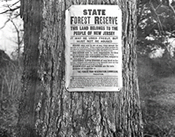Office of Sustainability
Planning for the Future by Learning from the Past
Sustainability requires an ability to visualize and plan for a future where natural resources are available for future generations. Visualizing a few generations into the future is challenging.
Perhaps a look into our past will help us visualize a sustainable future. Consider some U.S. statistics for the Year 1906:
- The average life expectancy in the U.S. was 47 years.
- Only 14 percent of the homes in the U.S. had a bathtub.
- Only 8 percent of the homes had a telephone.
- There were only 8,000 cars in the U.S., and only 144 miles of paved roads.
- The tallest structure in the world was the Eiffel Tower!
- The average U.S. worker made between $200 and $400 per year.
- Crossword puzzles, canned beer, and ice tea had not been invented yet.
- Two out of every 10 U.S. adults could not read or write.
- Only 6 percent of all Americans had graduated from high school.
Much has changed over the past 100 years. In part this comes from what was started during the last wave of the Industrial Era. Here is a look at some of the inventions from the early 1900s.
- In 1877 Thomas Edison invented the phonograph.
- In 1902 the air conditioner was invented.
- In 1903 the Wright brothers invent the first gas motored and manned airplane.
- In 1905 Albert Einstein published the Theory of Relativity and made famous the equation, E = mc2.
- In 1907 color photography was invented by Auguste and Louis Lumiere.
- In 1908 the first Model T was sold.
- In 1910 Thomas Edison demonstrated the first talking motion picture.
- In 1912 the first motorized movie cameras invented, replaced hand-cranked cameras.
|
A glimpse of where New Jersey was in the early 20th century?

NJ Forest Park Reserve Sign, Bass River State Forest, 1907
We are just beginning to realize the importance of our forests and the necessity for their preservation. They not only furnish timber and provide an important industry, but they beautify the country, temper the climate, hold the rainfall, fertilize the soil, furnish game preserves and conserve our water supply, an indispensable feature of our rapidly growing and congested civilization.- Governor Edward C. Stokes, Inaugural Address, January 17, 1905
During the 19th century the forests in New Jersey were cut down for farming and for lumber. Stokes State Forest was created in 1907 to counter this trend, when Governor Edward Stokes donated 500 acres (2.0 km2) of land in the Kittatinny Mountains and the State of New Jersey purchased 5,432 acres (21.98 km2). Stokes State Forest started with 5,932 acres (24.01 km2) and through the years, additional purchases accumulated to over 16,000 acres (65 km2). Formal trails were created in the 1930s by the Civilian Conservation Corps and white pine trees were planted. |
|
|